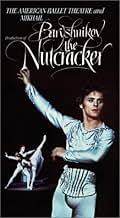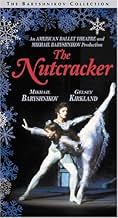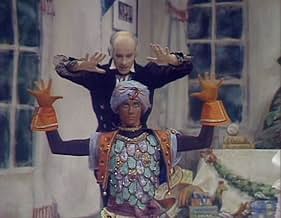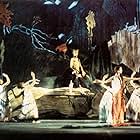The television adaptation of the Baryshnikov production.The television adaptation of the Baryshnikov production.The television adaptation of the Baryshnikov production.
- Nominated for 2 Primetime Emmys
- 2 nominations total
- Director
- Writer
- All cast & crew
- Production, box office & more at IMDbPro
Storyline
Did you know
- TriviaThis was originally a stage production, but rather than taping or filming it in a theatre with a live audience, Baryshnikov chose to have the sets enlarged and taped it in a television studio with no audience.
- Crazy creditsMarcos Paredes, who dances both the roles of The Mouse King and the drunken guest at the Christmas party, does not receive any screen credit for playing the drunken guest.
- Alternate versionsThe original CBS broadcast presentation of this production featured more narration than the later television broadcasts of it. In the original 1977 version, as the mice appear in their tuxedos, the narrator explains that, in Clara's imagination, they represent the adults at the Christmas party, and in Act II, just before the series of dances at the Kingdom of Sweets, the narrator mentions that Clara "must touch each couple to bring them to life". In the PBS version, all mention of the mice representing the adults was removed, but the narrator still commented that Clara had to bring the couples to life. On the current DVD, and on all PBS telecasts now, all narration stops after the opening scene. The narration was removed without having to cut any of the music or the dancing; both have always remained intact in all of the versions of this "Nutcracker".
- ConnectionsEdited into Breakfast with the Arts: The Nutcracker (1997)
- SoundtracksThe Nutcracker
(ballet)
Music by Pyotr Ilyich Tchaikovsky
Played by the National Philharmonic Orchestra, conducted by Kenneth Schermerhorn, with the boys of the Desborough School Chorus, conducted by Roger Durston
Featured review
The Nutcracker (1977) ballet starred then 29 year old Michail Baryshnikov who, in 1977, could out do Michael Jordan and Disney's Peter Pan (1952) in the "flying effortlessly" department. Baryshikov and his 1977 dance partner and muse, Gelsey Kirkland, defied gravity when this classic ballet was produced on monster, empty, no-audience TV sound stages in Toronto, Ontario, Canada. The camera didn't lie. Those two really did what viewers can still watch and admire, can still gasp at while smiling in delighted amazement.
Ballet is all about human beings who can fly ......... defy gravity when all is said and done. The best ballet dancers (Baryshikov and Kirkland in the 1977 version of The Nutcracker ballet) do it better than others ...... fly higher, longer, and smoother.
Not many ballet dancers (or people generally) can fly. That was true of the National Ballet Company of Canada supporting dancers who fill out the parts of this show when Baryshikov and Kirkland are not on stage, busy mesmerizing viewers.
Baryshikov and his management staff produced The Nutcracker in Canada on the cheap for TV broadcast. They went over the USA border to Canada where union problems and costs which encumber producers in USA ballet cities (New York City and Los Angeles) were not present, and where a very large, detailed, and gaudy background stage setting could be built on one of Toronto Canada's then huge sound stages.
The result was that Baryshinikov and Kirkland's amazing flying abilities were provided with a much more spacious venue than normal stages in the USA ever offer. The setting in the Nutcracker (1977) was spacious and wonderfully decorated, and the very space and stage decoration of this show became co-stars with the amazing flying dance abilities of the two major stars.
Michail Baryshikov was 29 years old in 1977, and was at the height of his airborne talents.
Baryshikov's choreography in the Arabian dance, Russian dance, Chinese dance segments of the presented ballet is absolutely unparalleled.
The action slows down when Baryshikov and Kirkland are not dancing.
National Ballet Of Canada dancers (probably not paid or rehearsed much for this thrifty dance show) perform for Michail Baryshikov and Gelsey Kirkland.
They are adequate. They are not brilliant or memorable. Not at all as good as the two main stars.
These secondary National Ballet Company Of Canada dancers perform by turns a Spanish dance, an Arabian dance, a Russian dance, a Chinese dance, each performed by a male and female duo. These secondary dancers are not gifted with the sort of precision and therefore the grace of the star dancers, and the contrast is noticeable.
Not to worry, not to gripe.
The chance to see Michail Baryshikov and Gelsey Kirkland dance (fly effortlessly) at the height of their dance careers and abilities is worth the price of admission and the time invested in watching their incredible performances. Never mind about less than ideal "fill in" parts of the show unavoidable because material resources (money!) was limited, and because spectacular dance talent is hard to find, manage, recruit. It's never cheap when it is presented, and the quest for "cheap" explains the shortcomings of this show.
"It's a waste of time to worry over things that they have not! Be thankful for ....................... the things they've got!" (There Is Nothing Like A Dame song from the broadway stage musical 1949 classic, South Pacific). -------------------------- Written by Tex Allen, SAG/AFTRA actor and movie historian. More about Tex Allen and his 119 IMDb movie reviews (as of December 26, 2017) by visiting IMDb.Com and using Tex Allen as search terms. --------------------------------------
Ballet is all about human beings who can fly ......... defy gravity when all is said and done. The best ballet dancers (Baryshikov and Kirkland in the 1977 version of The Nutcracker ballet) do it better than others ...... fly higher, longer, and smoother.
Not many ballet dancers (or people generally) can fly. That was true of the National Ballet Company of Canada supporting dancers who fill out the parts of this show when Baryshikov and Kirkland are not on stage, busy mesmerizing viewers.
Baryshikov and his management staff produced The Nutcracker in Canada on the cheap for TV broadcast. They went over the USA border to Canada where union problems and costs which encumber producers in USA ballet cities (New York City and Los Angeles) were not present, and where a very large, detailed, and gaudy background stage setting could be built on one of Toronto Canada's then huge sound stages.
The result was that Baryshinikov and Kirkland's amazing flying abilities were provided with a much more spacious venue than normal stages in the USA ever offer. The setting in the Nutcracker (1977) was spacious and wonderfully decorated, and the very space and stage decoration of this show became co-stars with the amazing flying dance abilities of the two major stars.
Michail Baryshikov was 29 years old in 1977, and was at the height of his airborne talents.
Baryshikov's choreography in the Arabian dance, Russian dance, Chinese dance segments of the presented ballet is absolutely unparalleled.
The action slows down when Baryshikov and Kirkland are not dancing.
National Ballet Of Canada dancers (probably not paid or rehearsed much for this thrifty dance show) perform for Michail Baryshikov and Gelsey Kirkland.
They are adequate. They are not brilliant or memorable. Not at all as good as the two main stars.
These secondary National Ballet Company Of Canada dancers perform by turns a Spanish dance, an Arabian dance, a Russian dance, a Chinese dance, each performed by a male and female duo. These secondary dancers are not gifted with the sort of precision and therefore the grace of the star dancers, and the contrast is noticeable.
Not to worry, not to gripe.
The chance to see Michail Baryshikov and Gelsey Kirkland dance (fly effortlessly) at the height of their dance careers and abilities is worth the price of admission and the time invested in watching their incredible performances. Never mind about less than ideal "fill in" parts of the show unavoidable because material resources (money!) was limited, and because spectacular dance talent is hard to find, manage, recruit. It's never cheap when it is presented, and the quest for "cheap" explains the shortcomings of this show.
"It's a waste of time to worry over things that they have not! Be thankful for ....................... the things they've got!" (There Is Nothing Like A Dame song from the broadway stage musical 1949 classic, South Pacific). -------------------------- Written by Tex Allen, SAG/AFTRA actor and movie historian. More about Tex Allen and his 119 IMDb movie reviews (as of December 26, 2017) by visiting IMDb.Com and using Tex Allen as search terms. --------------------------------------
- texallennyc
- Dec 25, 2017
- Permalink
Details
Contribute to this page
Suggest an edit or add missing content













